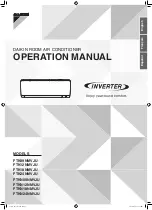
6.3 Connection of
refrigerant piping
The refrigerant piping is connected on the back
side of the units.
It may be necessary to fit a reducer or flared
adapter to the indoor unit. These fittings are
included with the indoor unit as an accessory kit.
Once installed, the connections should be insu-
lated to make them vapour diffusion proof.
NOTICE!
Installation should only be performed by
authorised specialists.
NOTICE!
The unit is factory filled with dry nitrogen for
leak testing purposes. The pressurised
nitrogen is released when the union nuts are
undone.
NOTICE!
Use only tools which are approved for use in
an HVAC environment. (z. B.: bending pliers,
pipe/tubing cutters, de-burrers and flaring
tools). Do not cut refrigerant pipes with a saw.
NOTICE!
All work must be carried out in a way that pre-
vents dirt, particles, water etc. from entering,
refrigerant lines!
The following instructions describe the installation
of the cooling cycle and the assembly of the indoor
unit and the outdoor unit.
1.
The required pipe diameters are given in the
table "Technical data".
2.
Install the indoor unit and connect the refrig-
erant piping as described in the operating
manual for the indoor unit.
3.
Use the wall or floor brackets to fit the out-
door unit against structural parts approved to
support the static load (refer to the installa-
tion instructions for the brackets).
4.
Ensure that structure-borne sound is not
transferred to parts of the building. Use vibra-
tion dampers to reduce the effects of struc-
ture-borne sound!
5.
Lay the refrigerant piping from the indoor unit
to the outdoor unit. Ensure that the fasten-
ings are adequate and if necessary, take
appropriate oil return measures!
6.
Remove the factory-fitted protective caps and
union nuts on the connections. These should
be used later in the installation process.
7.
Before flanging the refrigerant piping, ensure
that the union nut is fitted on the pipe.
8.
Prepare the laid refrigerant piping as shown
below (Fig. 39 and Fig. 40).
9.
Verify that the shape of the flange is correct
10.
First connect and hand-tighten the refrigerant
piping to ensure it is correctly seated.
11.
Then tighten the fittings with 2 appropriately-
sized open-ended spanners. Use one
spanner to counter the force when tightening
12.
Use insulation hoses which are designed for
this temperature range and are diffusion
proof.
13.
Observe the permitted bending radius for the
refrigerant piping during installation. Never
bend a pipe twice in the same place. Brittle-
ness and cracking can result.
14.
Apply appropriate heat insulation to the
installed refrigerant piping, including con-
nector.
15.
Take the same action at the shut-off valves
for all subsequent refrigerant piping.
31
Содержание RXT 1053 DC
Страница 62: ...Resistance values for probes T1 T2 T3 and T4 K Ohm K Ohm K Ohm K Ohm REMKO RXT DC 62 ...
Страница 63: ...Resistance values for probe T5 K Ohm K Ohm K Ohm K Ohm 63 ...
Страница 70: ...No Designation 31 Cooling fin 32 Fin motor 33 Refrigerant connections cover REMKO RXT DC 70 ...
Страница 77: ...No Designation 31 Shut off valve mounting plate 32 Condensate tray heating 33 Crankcase heating 77 ...
Страница 80: ...No Designation 31 Crankcase heating 32 Terminal block cover 33 Side panel right REMKO RXT DC 80 ...
Страница 82: ...REMKO RXT DC 82 ...
Страница 83: ......
















































